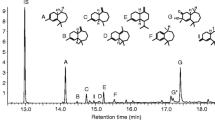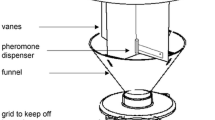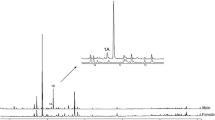Abstract
The parasitoidsB. intermedia andB. lasus aggregate at sites previously frequented. Extracts from filter paper conditioned by aggregated parasitoids were chromatographed (adsorption column and gas-liquid chromatography) and bioassayed. An active component that elicited aggregation response forB. intermedia was isolated and identified as 3-hexanone. This molecule was found in trace quantities (5–10 ng/female or male) on filter paper conditioned by either male, female or a combination of the sexes.
Similar content being viewed by others
References
Atkinson, W.D., andShorrocks, B. 1984. Aggregation of larval Diptera over discrete and ephemeral breeding sites: The implications for coexistence.Am. Nat. 124:336–351.
Blight, M.M., Wadhams, L.J., Wenham, M.J., andKing, C.J. 1979. Field attraction ofScolytus scolytus (F.) to the enantiomers of 4-methyl-3-heptanol, the major component of the aggregation pheromone.Forestry 52:84–90.
Borden, J.H., Handley, J.R., Johnston, B.D., MacConnell, J.G., Silverstein, R.M., Slessor, K.N., Swigar, A.H., andWong, D.T. 1979. Synthesis and field testing of 4,6,6-lineatin, the aggregation pheromone ofTrypodendron lineatum (Coleoptera: Scolytidae).J. Chem. Ecol. 5:681–689.
Brower, L.P., Calvert, W.H., Hedrick, L.E., andChristian, J. 1977. Biological observations on an overwintering colony of monarch butterflies (Danaus plexippus, Danaidae) in Mexico.J. Lepid. Soc. 31:232–242.
Brownlee, R.G., andSilverstein, R.M. 1968. A micropreparative gas chromatograph and a modified carbon skeleton determinator.Anal. Chem. 40:2077–2079.
Byrne, K.J., Swigar, A.A., Silverstein, R.M., Borden, J.J., andStokkink, E. 1974. Sulcatol: Population aggregation pheromone in the scolytid beetle,Gnathotrichus sulcatus.J. Insect Physiol. 20:1895–1900.
Capinera, J.L. 1979. A trail pheromone from silk produced by larvae of the range caterpillarHemileuca oliviae (Lepidoptera: Saturniidae) and observations on aggregation behavior.J. Chem. Ecol. 6:655–665.
Cavill, G.W.K., Robertson, P.L., andDavies, W.W. 1979. An argentine ant aggregation factor.Experientia 35:989–990.
Crins, W.J. 1980. Two aggregations ofCalosoma figidam (Coleoptera: Carabidae) in Ontario during 1976.Entomol. News 91:155–159.
Evans, H.E., and GIllaspy, J.E. 1964. Observations on the ethology of digger wasps of the genusSteniolia (Hymenoptera: Sphecidae: Bembicini).Am. Midl. Nat. 72:257–280.
Faustini, D.L., Giese, W.L., Philips, J.K., andBurkholder, W.E. 1982. Aggregation pheromone of the male granary weevil,Sitophilus granarius (L.).J. Chem. Ecol. 8:679–686.
Gillet, S.D. 1973. Social determinants of aggregating behavior in adults of the desert locust.Anim. Behav. 21:599–606.
Gillet, S.D. 1975. Changes in social behavior of the desert locust,Schistocerca gregaria, in response to the gregarizing pheromone.Anim. Behav. 21:599–606.
Gore, W.E., Pearce, G.T., Lanier, G.N., Simeone, J.B., Silverstein, R.M., Peacock, J.N., andCuthbert, R.A. 1977. Aggregation attractant of the European elm bark beetle,Scolytus multistriatus production of individual components and related aggregation behavior.J. Chem. Ecol. 3:329–446.
Hayamizu, E. 1984. Comparative studies on aggregations among aphids in relation to population dynamics. II Effects of aggregation on the growth and fecundity ofBrevicoryne brassicae L. andMyzus persicae. (Sulzer) (Homoptera: Aphididae).Appl. Entomol. Zool. 19:468–475.
Harris, V.E., andTodd, J.W. 1980. Male-mediated aggregation of male, female, and 5th instar southern green stink bugs and concomitant attraction of tachinid parasite,Trichopoda pennipes.Entmol. Exp. Appl. 27:117–126.
Hefetz, A., Batra, S.W.T., andBlum, M.S. 1979. Linalool, neral and geranial in the mandibular glands ofColletes bees—an aggregation pheromone.Experientia 35:133–135.
Lee, R.E. 1980. Aggregation of lady beetles on the shores of lakes (Coleoptera: Coccinellidae).Am. Midl. Nat. 104:195–305.
Simser, D., andCoppel, H.C. 1980. Aggregation behavior ofBrachymeria lasus (Walker) in the laboratory.Environ. Entomol. 9:486–488.
Stenhagen, E., Abrahamsson, S., andMcLafferty, F.W. (eds.). 1974. Registry of Mass Spectral Data. Wiley-Interscience, New York.
Suzuki, T., andMori, K. 1983. (4R,8R)-(+)-4,8-Dimethyldecanal: The natural aggregation pheromone of the red flour beetleTribolium castaneum (Coleoptera: Tenebrionidae).Appl. Entomol Zool. 18:134–136.
Waldvogel, M.G., andBrown, M.W. 1978. An overwintering site of the gypsy moth parasite,Brachymeria intermedia.Environ. Entomol. 7:782.
Rights and permissions
About this article
Cite this article
Mohamed, M.A., Coppel, H.C. Pheromonal basis for aggregation behavior of parasitoids of the gypsy moth:Brachymeria intermedia (Nees) andBrachymeria lasus (Walker) (Hymenoptera: Chalcididae). J Chem Ecol 13, 1385–1393 (1987). https://doi.org/10.1007/BF01012285
Received:
Accepted:
Issue Date:
DOI: https://doi.org/10.1007/BF01012285




